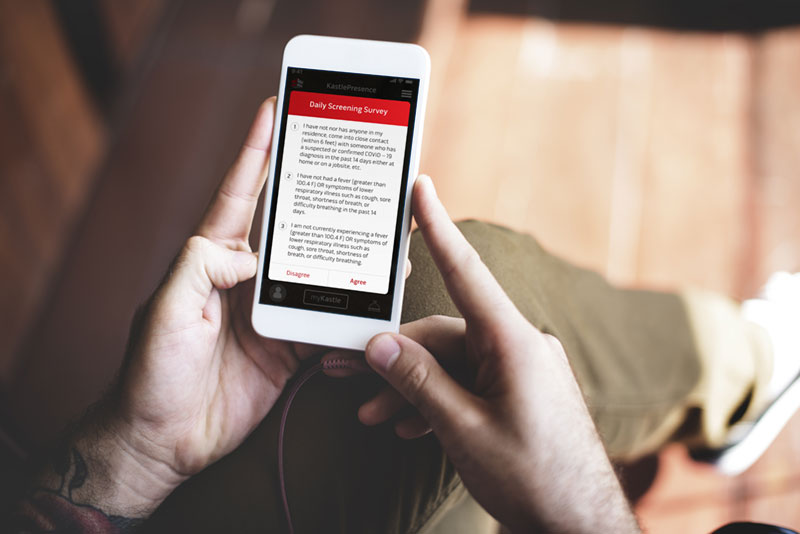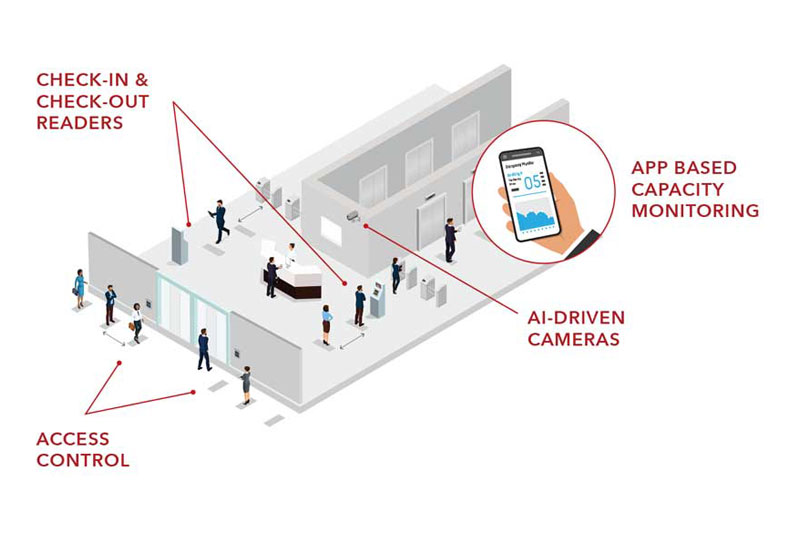The return to work following the COVID-19 pandemic is confusing and ever-evolving. Will those who have been working remotely now come back to the office? If so, will it be full time? Will the same teams and job duties exist? What has changed in terms of processes, offerings, and even culture? Such questions are likely to be on the minds of employees, so leaders should be ready with answers.
Another top area critical for leaders to think and communicate about is employee health. While vaccines and masking may make it safer to return to work, uncertainties still exist. An important step employers can take to keep workers, clients, vendors, and visitors well is to regulate how workplace occupants gather in enclosed spaces. This effort will serve companies now, as effects of the pandemic continue to linger, and later if future public health issues arise.
From staggering workdays to continuously tracking space occupancy, leaders can help team members feel more at ease as they return to work in office environments. Here we offer several tips to track office occupancy levels to ensure the optimal conditions for employee health during this challenging transition.
Stagger work schedules
One of the best ways to control office occupancy levels is to institute staggered schedules. This strategy minimizes the number of people in the workspace at any given time, enabling easier social distancing. Workers can be assigned entry and exit times of the day or separate days of the week to work on-site, reducing the number of people in shared spaces at any given hour.
As team members return to work, employers can also limit occupancy by using a sign-up system in which team members choose or are assigned specific blocks of time when they can be in the office. Once a shift is filled to a maximum number of people determined for optimal health and safety, no more can sign up. Advanced access control systems can be used by administrators to ensure enforcement of a staggered work program by varying the schedule of occupant access privileges such that an individual’s access credential only operates during their assigned timeframes, and they can only enter when they are expected.
This type of system works well for environments in which not everyone must be present at the same time for the business to function well. It is also best for teams in which members have the ability to work remotely when they’re not in the office.
Managing employee access
Staggered work programs help teams plan schedules in advance. But what about keeping tabs on worker presence in real-time or historically? Employers can deploy an entry/exit monitoring system, such as an electronic workplace access control, to detect precisely how many individuals are in defined areas at one time. If space capacity is reached, the system can prevent additional people from entering.
 Individual access privileges can also be programmed at the credential level to include vaccination status as admission criteria for businesses that have vaccination requirements. Companies may want to have special policies concerning unvaccinated individuals and extra steps they must take to be allowed entry or even disallow them from entering the building at all.
Individual access privileges can also be programmed at the credential level to include vaccination status as admission criteria for businesses that have vaccination requirements. Companies may want to have special policies concerning unvaccinated individuals and extra steps they must take to be allowed entry or even disallow them from entering the building at all.
Restrict visitor access
While employees may be aware of company health screening policies and procedures, vendors and visitors may not be. Regulating their access is highly important for minimizing health and security risks. Employers can deploy an electronic guest scheduling and registration system that enables staff to schedule visitor access times as well as limit how many visitors can be on-premises at one time. To elevate safety even further, companies may choose to install a self-service access device or kiosk in the lobby so visitors can self-register without interacting with the front desk staff.
Both employees and visitors can be required to check out as well as check-in, so the system knows exactly how long they were in the building, and, with the help of strategically placed access readers, even which spaces they were in. Such data improves the accuracy of the contact tracing efforts mentioned below.
Screen health status
 Employers can use painless, non-intrusive methods for identifying employees or visitors who may be contagious. Such methods may include app-enabled questionnaires, temperature checks, thermal cameras, or direct virus testing. Facility managers can equip lobbies with testing stations, screening queues, and self-check kiosks, and employees and visitors may be asked to adhere to specified check-in times. Companies may alternatively or additionally choose to use virtual health checks, which enable individuals to report the presence or absence of symptoms via an app such as on a smartphone access credential.
Employers can use painless, non-intrusive methods for identifying employees or visitors who may be contagious. Such methods may include app-enabled questionnaires, temperature checks, thermal cameras, or direct virus testing. Facility managers can equip lobbies with testing stations, screening queues, and self-check kiosks, and employees and visitors may be asked to adhere to specified check-in times. Companies may alternatively or additionally choose to use virtual health checks, which enable individuals to report the presence or absence of symptoms via an app such as on a smartphone access credential.
Those who are found to be potentially unwell may be asked to quarantine for a specified period before returning and tracked within a tracking system to ensure they do. These checks create a healthier, more secure environment for everyone as they return to work.
Perform contact tracing
In addition to limiting occupancy, access control data can be effectively used in contact tracing should an individual occupant be diagnosed with an infection. It provides a detailed account of their onsite presence along with the other individuals that were on-premises during the same period.
 Employers can alert those who may have been in contact with contagious individuals, using data and camera footage pertaining to users of the same entry points and offices. Potentially infected individuals get an early warning of the situation, enabling them to seek immediate medical care. Companies may decide to institute a quarantine requirement for anyone alerted, using system tracking to ensure they don’t return until after the specified period.
Employers can alert those who may have been in contact with contagious individuals, using data and camera footage pertaining to users of the same entry points and offices. Potentially infected individuals get an early warning of the situation, enabling them to seek immediate medical care. Companies may decide to institute a quarantine requirement for anyone alerted, using system tracking to ensure they don’t return until after the specified period.
Facility managers concerned about privacy issues may choose to consult with public health and privacy experts as well as their own HR departments to ensure all personal information is used appropriately.
Kastle can help
The steps mentioned here are important for keeping workers healthy and safe in the post-pandemic world and technology gives businesses effective ways to perform them. KastleSafeSpaces® is one platform that can help employers effectively manage occupancy using existing access control technology. Kastle reconfigured its existing access control technology for this purpose to include touchless access, vaccine status referencing, health screening protocols, capacity monitoring, touchless elevator operation, touchless visitor processing, and contact tracing features.
KastleSafeSpaces is a simple way to help commercial property managers, facility management professionals and HR office managers safely transition the workforce back to on-premises operations. By configuring existing access control technology, the platform keeps spaces secure and allows for effortless administration, with the ability to record and enforce health screening protocols into the daily office routine.
